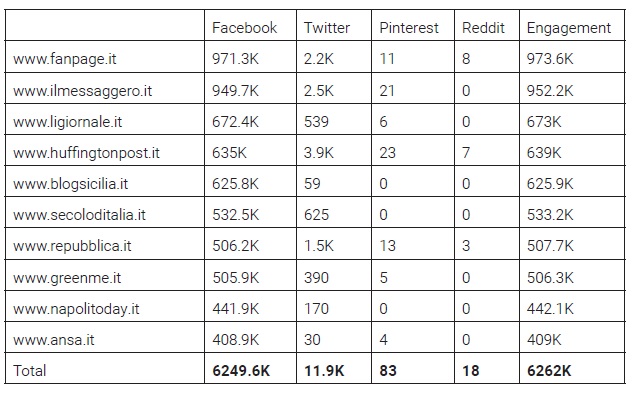Context
Coronavirus (COVID-19) is an infectious disease caused by a new strain of COVID-19, SARS-CoV-2, which was announced for the first time on December 31, 2019 in the Chinese city of Wuhan (World Health Organization, 2020a). The first people infected with COVID-19 in Europe were detected in France, on January 25, 2020, and in Germany, on January 27, 2020. However, on February 21, 2020 in the Italian region of Lombardy, the first outbreak was reported within the European Union. The number of infected grew rapidly in the country, which led the government to order a state of alarm and a mandatory quarantine on March 10, 2020. The following day, the World Health Organization (World Health Organization, 2020b) recognized the disease as a pandemic and by August 30, 2020 they had reported a total of 24,822,800 confirmed cases and 838,360 deaths worldwide (World Health Organization, 2020c).
The phenomenon quickly became a central topic on mass media agendas around the world because it coincided with nearly all the newsworthy criteria (O'Neill & Harcup, 2009), which were:
Unexpectedness (sudden outbreak) as well as consonance with expectations (a new pandemic was long predicted), intensity increase (growing number of patients and fatalities), negativity (chance of a catastrophe), relevance (current risks involved), meaningfulness (fear of epidemic, personal risks), unambiguity (flu is well known), continuity (daily updates) and unpredictability (will it be a severe epidemic?) (Vasterman & Ruigrok, 2013, p. 437).
Reporting on a pandemic like COVID-19 is a challenge for the media because they produce news based on unpredictable information that occurs in the moment (Ratzan et al., 2020). During times of emergency, its role when facing the fear of the citizens, the hysteria of the financial sector and the unintentional misunderstandings of science is fundamental and simple, truthful, timely and evidence-based information must be provided (Villena-Alarcón & Caballero-Galeote, 2020). Managing a pandemic requires a balanced approach that conveys what citizens and the health system can do without causing panic (Cowper, 2020).
There are multiple investigations that have studied the impact of media coverage on the perception of the COVID-19 pandemic. Some have indicated that journalistic companies were able to stop the spread of the disease at an early stage (Zhou et al., 2020). Others noted that the media had a negative influence because they encouraged racial attacks by using terms such as "Chinese virus" or rating the disease as being a "Chinese virus pandemonium" (Lyu et al., 2020; Zheng et al., 2020). These studies show that the media is a powerful tool in setting up the public agenda. By selecting the content to transmit and from what perspective, they influence citizens' perceptions. This demonstrates the need to study how the media covers certain topics using theories such as agenda setting and framing, whose point of convergence is the structure and content of information published by the media.
The agenda-setting theory was posed by McCombs & Shaw (1972) as a result of Cohen's thesis (1963), where he argued that the media does not indicate how to think, but what to think about. According to this theory, the media directs the public's attention and influences their perception of the most important topics with the daily selection and distribution of information. “This ability to influence the relevance of the public repertoire is what has been called agenda setting by the news media” (McCombs, 2006, p. 24). Citizens take these cues and use them to organize their own agenda and decide which issues are most important. Over time, these issues become the most relevant ones to the public. As a result, the media agenda becomes the public agenda (McCombs, 2006; Justel-Vazquez et al., 2016).
The main premise of the framing theory, or the frame, is that a phenomenon can be seen from a variety of perspectives and interpreted from multiple principles or considerations. The term frame first appeared in the field of psychology by Gregory Bateson (Sadaba, 2008) and was later put into the social context by sociologist Erving Goffman (Koziner, 2013). The application of framing in communication research has a solid trajectory that allows one to consider the theory as being key (Vicente-Mariño & López-Rabadán, 2009). From a media point of view, a frame serves to organize everyday realities (Tuchman, 1978) and provide meaning to current events (Gamson & Modigliani, 1989). Framing involves selecting, emphasizing and structuring information to set a perspective from which to interpret a particular topic (Fenoll & Rodríguez-Ballesteros, 2017). The news is thus considered to be like a window whose frame determines the reality that one has access to and focuses the attention on a specific item while limiting the perception of other realities (Tuchman, 1978). Therefore, framing can be defined as a process in which some aspects of reality are selected in order to define the problem, diagnose its causes, suggest moral judgments and provide behaviors to follow (Entman, 1993).
Some authors argue that framing is the equivalent of the second level of the agenda-setting theory (McCombs et al., 1997) because it uses frames as a characteristic that, because of its complexity, allows us to define a problem, interpret its causes or propose a process (McCombs, 2006).
Concerning health issues, such as the COVID-19 pandemic, the media has proven to be a source of relevant information for the majority of the population. Due to the exceptionality and severity of the COVID-19 outbreak, citizens had increased access to information (Singh et al., 2020) and the news became a precious and valuable commodity in handling the situation (Casero-Ripollés, 2020). According to Comscore’s analysis (2020), the area with the fastest growing consumption of news during confinement was the Internet, whose peak usage coincided with the first steps taken by different governments to curb the spread of the virus. In Italy, the first European country hit hard by the virus, the peak was recorded between the 2nd and 8th of March. On March 2, the Italian Prime Minister Giuseppe Conte divided the country into four zones according to the severity of the epidemic in order to implement measures to restrict activities (Corriere della Sera, 2020). On March 8, he extended the measures to all of Lombardy and 14 northern provinces, putting more than a quarter of the Italian population under quarantine (Repubblica, 2020).
The most notable change in citizen information consumption habits was identified in digital, general news media, whose traffic in Italy soared between the 17th and 23rd of February, 2020 (Comscore, 2020). This coincided with the knowledge of the first infected people in the Lombardy region. The rise in the number of deaths in Italy, which was recorded between March 6-10, was another key moment in the change in information consumption as 93% of the population claimed to consult news at least once a day by mainly accessing national government websites (66%) and news companies (55%) (Edelman, 2020).
This shows the importance of new technologies (broadband), new devices (computers, mobile phones, tablets) and new areas of interaction (social networks) in the production, dissemination and consumption of informative content. Using social networks for journalistic writing rose the most as they became important channels for distributing information, extracting ideas and increasing website traffic (Hermida et al., 2012; Lee, 2016; Sacco & Bossio, 2017; Thurman, 2018). Not only did they become a valid source of information (Pedriza, 2018; Justel-Vázquez et al., 2018), especially in the emergence of unforeseen events (Pérez-Soler & Micó, 2015), but they led the media to adapt information content according to the logic of consumption (Hernández-Pérez & Rodríguez-Mateos, 2016).
On these platforms, the audience’s exposure and interaction with the information is particular (Ahmadi & Wohn, 2018) because they encounter news content without intending to do so (Fletcher & Nielsen, 2018; Yadamsuren & Erdelez, 2010). Internet and social network users accidentally discovered news while engaging in other on-line activities, both related to and not related to the information content (Tewksbury et al. 2001). This way of accessing information "is brief, interrupted and partial and its consumption is ephemeral", but it is also "both the symptom and the cause of lasting, constant and integral transformation" (Mitchelstein & Boczkowski, 2018, p. 143). Previous research shows that this incidental exposure to news plays an important role in accessing useful, valuable information (Boczkowski et al., 2018; Oeldorf-Hirsch, 2017; Yadamsuren, 2009). Due to the possibilities provided by this type of exposure, social media users are becoming less and less likely to search for news, which could limit them in their understanding of current events (Oeldorf-Hirsch, 2017). However, previous research shows that active participation between users and content on social networks may increase their involvement (Greenhow & Reifman, 2009; Oeldorf-Hirsch & Sundar, 2015) and emotional relationship (Yadamsuren & Heinstr.m, 2011) to current, emerging issues. This has made social networks a source of information (Gottfried & Shearer, 2016; Oeldorf-Hirsch, 2017) for a growing number of citizens with Facebook being the most widely used social network in Italy according to Reuters Institute for the Study of Journalism (Coppola, 2020b), which attracts many journalistic pieces that seek to communicate and interact with their audiences (Al-Rawi, 2017; Duffy & Knight, 2019).
Including the audience on social networks is important for the survival of the media (Hernández-Pérez & Rodríguez Mateos, 2016) because it is a part of its structure as well as being a source for funding and advertising (Tandoc & Maitra, 2018). In this context, it is essential to measure the consumption and the involvement of users with the information products that are put into circulation. As such, engagement is used as a measure that quantifies the interaction of users with the brand and its content, which is disseminated in different digital spaces (Hollebeek et al., 2014; Raimondo Anselmino, 2017). This interaction is relevant because it can affect the user's purchase intent (Park et al. 2009; García-Medina et al. 2018) and build and manage the identity of the brand (Arvidsson & Caliandro 2015).
Objectives and Method
This article analyzes media behavior and citizens' information consumption in the face of a crisis, such as that created by the COVID-19 pandemic. The article aims to provide a snapshot of the behavior adopted by Italy's main digital media (Coppola, 2020 Cazzola, 2020) during the pandemic and user interaction with the content published. To this end, the following specific objectives are proposed:
O1: Discover the presence of content related to the COVID-19 pandemic in Italy’s main digital communication media.
O2: Understand the timeframe evolution of the production of information related to the health crisis.
O3: Ranking of the ten media outlets with the highest engagement with the terms Coronavirus and COVID-19.
O4: Discover which social network generated greater engagement with citizens who accessed information pertaining to the pandemic.
To carry out this longitudinal research, the quantitative method was primarily used and the qualitative method was used only to identify the tone of predominant headlines. The sample is made up of informative content pertaining to the pandemic published by 30 of Italy's predominant digital media (.it) between January 1 and April 27, 2020. These dates coincide with the beginning of global media interest in COVID-19 and maximum mortality in the country. For data collection, the Buzzsumo application search tool was used and the following filters were applied: timeframe (January to April), geographic (Italy) and semantics (COVID-19 and Coronavirus). The total sample is 841,786 news items.
The information was processed using the quantitative content analysis technique, which allowed for the systematic, objective and calculable study of variables to measure and achieve an accurate representation of the content (Wimmer & Dominick, 2010). The sample was recorded in a spreadsheet where, in addition to quantifying the total news collected, categories were proposed in order to meet the objectives. First, the content was classified according to publication date, number of pieces of information published with the terms most commonly used in reference to the health crisis (Coronavirus and COVID-19) and web analysis to determine their respective engagement. Then, a list of ten different media outlets and their ten major news stories with the most engagement among readers was recorded. Based on this list and previous research, categories of analysis were established to study the subject (López-Rabadán & Casero-Ripollés, 2012; Laferrara & Justel-Vázquez, 2020) and the predominant tone (positive, neutral or negative) of the headlines (Bardin, 1986; García Ferrando et al., 1986; López Aranguren, 1989; Piñuel & Gaitán, 1995).
Results:
The data collected for this investigation indicates that the contents relating to the COVID-19 pandemic were a substantial aspect of Italy's media agenda between January 1 and April 27, 2020. During this period, the media analyzed totaled 841,786 pandemic-linked publications, of which 759,316 contained the term Coronavirus and 82,470 had the term COVID-19. Coronavirus thus became the concept most used by Italian digital media to publicize information on the health crisis, which was reflected in the engagement data collected (table 1).
Table 1 Number of publications in Italian digital media using the terms Coronavirus and COVID-19 between January 1 and April 27, 2020, along with their engagement totals and engagement ratio.

Sources: Javier Sierra Sánchez, Valentina Laferrara and Míriam Díez Bosch.
According to the data collected, the Italian media began to show interest in COVID-19 on January 21, 2020 (Figure 1). This coincided with the detection of the first person infected outside of Asia, in the United States. There was a slight increase in information production on February 2, 2020, when Italian Minister of Health, Roberto Speranza, reported that COVID-19 had been isolated in a hospital in Rome in order to study it, understand it and attempt to stop its spread. The news came two days after the contagion of two Chinese tourists were detected in that same city. The explosion of information production occurred on February 20, the day before the authorities of ten northern Italian locations ordered the closure of all public places due to the detection of 17 infected people, 2 of whom were from Veneto and 15 were from Lombardy. From that moment on, information activity was high in all of the major Italian media analyzed. The date with the highest production of news about the pandemic was March 9 when Italy became a "protected zone" and all human movement was prohibited. Information activity began to fall on March 17, even though the pandemic continued to have an important place in the media agendas that were analyzed.
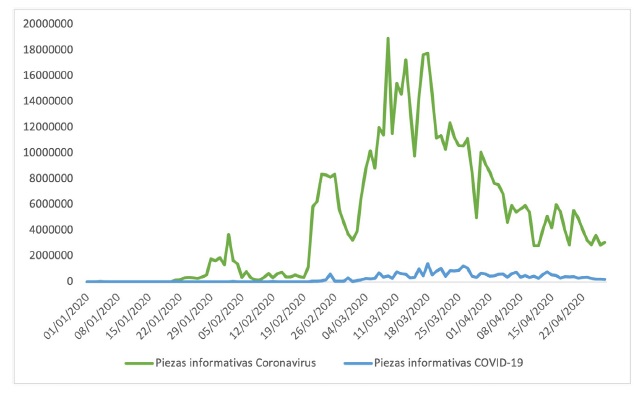
Source: Javier Sierra Sánchez, Valentina Laferrara and Míriam Díez Bosch.
Figure 1 Number of media publications analyzed that used the terms Coronavirus and COVID-19 between January 1 and April 27, 2020
To meet the third objective of this study, the ranking of ten media outlets with the greatest engagement with the two specialized terms of information was developed (Table 2). The ranking for the Coronavirus concept consists of six general-interest newspapers (Repubblica, Fanpage, Corriere della Sera, Il Messaggero, Il Fatto Quotidiano, The Post Internazionale), an informative television channel (TGcom24) and a news agency (ANSA). With the exception of the online newspaper, Fanpage, all the others in this ranking have a paper version as well. The media ranked with the highest engagement for the term COVID-19 is composed of nine general-interest newspapers (Fanpage, Il Messaggero, Il Giornale, Huffington Post, Secolo d'Italia, Napoli Today, Blog Sicily, Malpensa 24, Repubblica) and a specialized one called Green Me. Seven of these media outlets are entirely digital and three feature a paper version as well.
Table 2 Ranking of ten media outlets with the highest engagement with the terms Coronavirus and COVID-19.
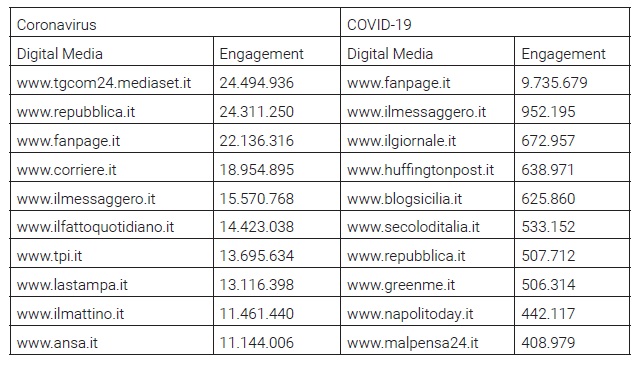
Source: Javier Sierra Sánchez, Valentina Laferrara and Míriam Díez Bosch.
In order to approximate the preferential COVID-19 pandemic information consumption of Italian citizens, the ten most important news articles with engagement were extracted from the previous ranking for both the term Coronavirus (table 3) and COVID-19 (table 4). It is apparent from the analysis of both rankings that 55% of the total news with the highest engagement were published during March, when the first major spike in the number of infected was recorded and the state of alarm was decreed, followed by April (25%) and February (20%). Directly proportional was the number of publications on the pandemic (see Figure 1).
The predominant topics in the news with the greatest engagement are politics (30%) with information relating to the authority’s general management of the COVID-19 pandemic, and health and science (30%) with information relating to the spread of the virus, medical research and scientific progress. Next is news that appeals to human interest and/or deals with collaborative initiatives (25%), such as the publication by Green Me about a dog who provided comfort to doctors and nurses during the emergency. News of people who contracted the virus (15%), economy (15%) and religion (15%) were less relevant. It is also apparent from the analysis that the predominant headline tone was positive (45%), followed by negative (30%) and neutral (25%).
Table 3 Top ten news articles with the highest engagement in the Coronavirus category.
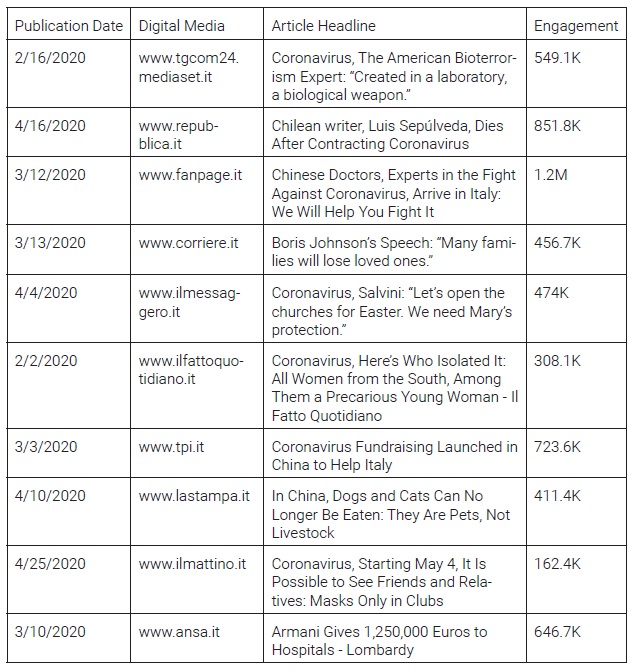
Source: Javier Sierra Sánchez, Valentina Laferrara and Míriam Díez Bosch.
Table 4 Ten news articles with highest engagement in COVID-19 category. Source: The author.
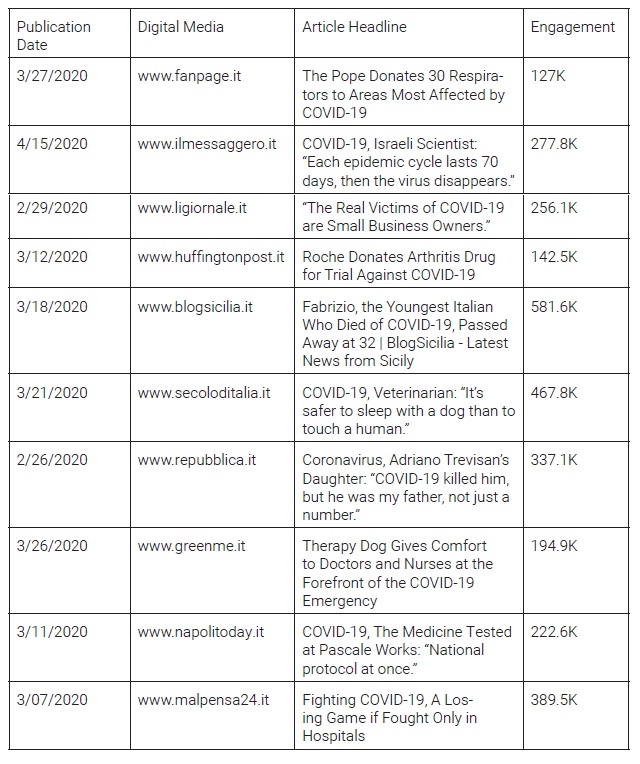
Source: Javier Sierra Sánchez, Valentina Laferrara and Míriam Díez Bosch.
The data collected indicates that Facebook was the social network that generated the highest engagement with users who accessed the content published by Italian digital media in relation to the health crisis (tables 5 and 6). It is followed by Twitter, although with much less engagement. Pinterest and Reddit generated a minor reach. Facebook thus became the preferred social network for news consumption and offered the highest incidental exposure of informational content to its users. This data supports the conclusions of the Reuters Institute for the Study of Journalism (Coppola, 2020b).
Table 5 Social networks with the highest engagement of content referring to the crisis using the term Coronavirus.
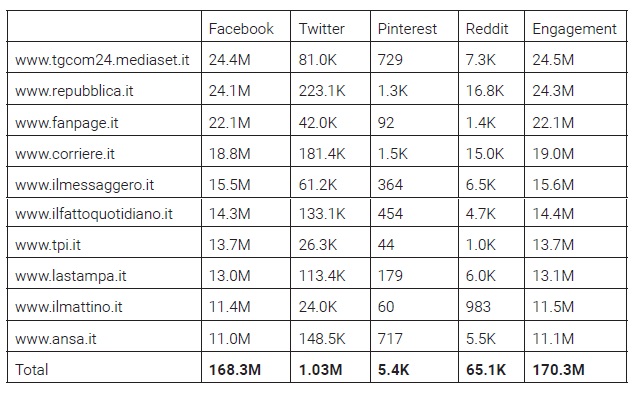
Source: Javier Sierra Sánchez, Valentina Laferrara and Míriam Díez Bosch.
Discussion and Conclusions
This article is logical when taking into account the context generated on the web following the outbreak of the health crisis in Italy. The phenomenon, which alarmed the world's population and kept millions of people quarantined, caused increased access to information (Singh et al., 2020) and turned the news into a prized commodity for handling the situation (Casero-Ripollés, 2020). The fastest growing category was the Internet, in part because consumption of main, digital media skyrocketed (Comscore, 2020). The phenomenon soon caught the attention of academics interested in understanding the media’s action in the face of this unprecedented event and its impact on citizen perception of the health crisis (Lyu et al., 2020; Zheng et al., 2020; Zhou et al., 2020). This article makes a significant contribution in this regard as it provides a snapshot of the behavior of Italy’s main digital media during the COVID-19 outbreak and citizen interaction with the content they published.
The results of the research reinforce what has been found in previous studies on the prominence of emergencies, such as a pandemic, in various media agendas (O'Neill & Harcup, 2009; Vasterman & Ruigrok, 2013; Ratzan et al., 2020). Since the emergence of the first infected person outside of the Asian continent, Italian digital media has shown a constant interest in information regarding the COVID-19 outbreak. In fact, the amount of publications on the pandemic was high over the last two months and showed informational spikes that coincided with the emergence of information most needed to handle the situation. The amount of information proved to be directly related to the capacity of engagement generated with users, suggesting that greater news production expands the chances of impacting citizens.
The term Coronavirus was used more at the informative level to approach the phenomenon of the health crisis because, compared to the term COVID-19, it is more understandable and, therefore, easier for the general user. After all, it is the work of the media to provide information that is easily understood (Villena-Alarcón & Caballero-Galeote, 2020). The main and classical media, with consolidated paper versions that had content adapted to the digital environment, achieved the highest capacity of engagement during the three months studied. This suggests that, in emergency situations such as the pandemic under study, citizens choose to consume information from media whose original editions are traditional. However, the results show that all-digital media is beginning to gain ground in this regard. The results also indicate that, in times of crisis, such as that caused by COVID-19, citizens tend to consume information with positive headlines. This may be because they offer a sense of calm and security.
Facebook has proven to be the social network with the greatest capacity of engagement containing information content concerning the health crisis. Although with much less capacity, Twitter has also proven relevant. Pinterest and Reddit, however, have shown they made a limited contribution in this regard. The results of this study reinforce what is indicated in previous research concerning the necessary relationship between media and social networks because they offer the possibility to distribute information, increase website traffic and interact with audiences (Hermida et al., 2012; Lee, 2016; Al-Rawi, 2017; Sacco & Bossio, 2017; Thurman, 2018; Duffy & Knight, 2019). The latter becomes relevant as long as the media structure is based on audiences and sources of funding (Tandoc & Maitra, 2018).
This study mainly offers quantitative information, so future research could address the issue from a qualitative approach based on interviews with media managers, focus groups and citizens who experienced the health crisis. It would also be worth investigating why traditional media continues to be a reference in times of emergency and how they adapt their content to the digital environment.














